Wider World
Feature
Passage Over the Pyrenees
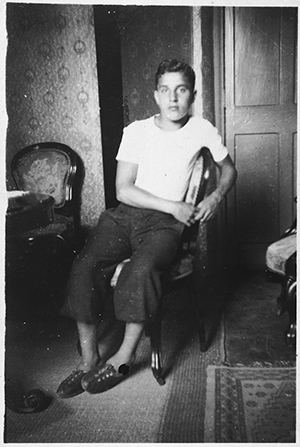
It was June 1944 when 19-year-old Ruth Usrad, née Schütz, arrived in the Pyrenees mountain village of Quillan in France. She had been on the run from the Nazis for over four years.
Her flight had begun in Berlin after she bullied her and her sister’s way onto a Kindertransport to Brussels and continued in the French countryside, where they were hidden with 99 other children. When the youngsters’ whereabouts were betrayed to the authorities, Usrad was imprisoned in an internment camp, then miraculously freed. She then became part of the French underground, and after she was put on a Gestapo blacklist, the Armée Juive (Jewish Army), an armed Zionist guerilla group of about 2,000, made arrangements for her passage to freedom over the Pyrenees.
“When I got off the train in Quillan, I saw the husky man wearing a black Basque beret, the sign I had been told to look for,” recalled Usrad. “He was standing at the end of the platform, gesturing to follow. I found myself with eight other people as he led us through woods and thick bushes to rendezvous with our Spanish guide. I had no idea the difficult path that lay ahead.”
From the early 1940s until the end of the war, thousands of Jewish refugees escaped by foot over the Pyrenees, a mountain range that forms a natural 305-mile border between France and Spain. Jews were not the only ones using the remote mountain passes. Frenchmen hiked the mountain passes trying to reach Charles de Gaulle’s Free French Forces, and British and American pilots shot down in enemy territory fled over them into Spain. The Pyrenees had dangerous, unpredictable weather and rugged, snowy terrain. But there was an equally perilous threat: immediate death or deportation to labor or extermination camps if discovered by the Nazis or French Vichy police.
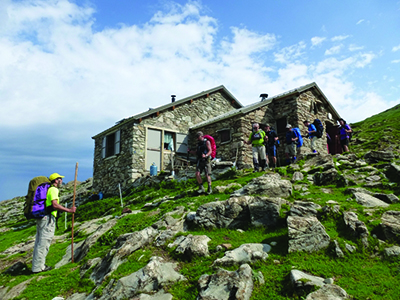
Today, a handful of tour operators have organized treks of varying difficulty that follow different Pyrenees escape routes. Some begin in France, others in Spain; some last a few hours, others take several days.
The most established trail was blazed and organized in 1993. Le Chemin de la Liberté, The Freedom Trail, is a four-day commemorative hike that takes place every July; there were 87 participants last year. The trail reaches an altitude of 8,500 feet, and trekkers are expected to train beforehand. Many hikers are families and friends of Allied war veterans. One of the trek’s organizers, Scott Goodall, has hiked it 15 times. “The first two days are mainly through woods and valleys,” explained Goodall, 80. “But days three and four are bloody hard, which is why I stopped doing it in 2006.”
Suranga Gail Yizhaky, owner of Astha & Suranga, a boutique tour operator in Tel Aviv, organized an inaugural trip for 19 Israeli women, ages 33 to 70, in October 2014. The four-hour hike began in a remote area in the Pyrenees and ended in Tavascan, Spain, one of the mountain villages Jewish refugees passed through. “I felt humbled during the entire hike,” said Yizhaky. “With every step on this trail, I knew I was connecting to an important part of our Jewish history.” Astha & Suranga is leading treks over the Pyrenees in August and October.
During the war, some refugees traveled alone, but most were led by paid guides, passeurs in French, pasadors in Catalan or Spanish. The guides ranged from former Republican soldiers on the losing side of the Spanish Civil War to local farmers, smugglers, other Jewish refugees or members of the underground. Some did it for the cause, others for the money. Some were honest, some not. The number of people who attempted to cross but never made it will never be known.
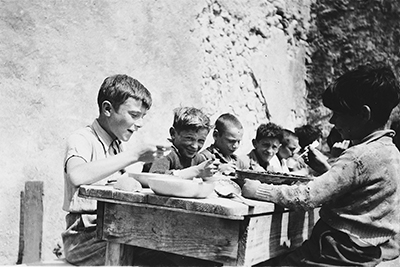
Usrad remembered how she walked nonstop up a small incline during her nearly weeklong trek. “My backpack was heavy and my legs were not yet accustomed to my new shoes,” she said. “When we finally rested, I sank down and wondered if I’d have the energy to get to Spain when I was already so tired.”
The quickest route was near the Mediterranean coast, where the elevation was more manageable but the pass was heavily guarded. As the Nazis tightened the borders, the guides had to find new escape routes, taking refugees into waist-deep snow or sleeping in caves after getting caught in blizzards.
That happened to Michel Margosis, who was 14 when he crossed with his two older siblings and his mother in November 1942. “I was a teenager, so at first it was an adventure,” recalled Margosis, who was born in Brussels (his family was originally from Odessa). “But that changed after we heard barking dogs and a German voice shouting commands. We froze in our tracks. Our guides quickly changed direction and we continued on a much more difficult climb.”
Brothers Fred and Gus Manasse were just 9 and 13, respectively, when they were led to freedom by the underground during the winter of 1944. Though born in Frankfurt into a family whose roots in Germany went back 500 years, their flight took them to Brussels before the Kindertransport brought them to the foot of the Pyrenees. “In our trek, we only had rags for boots and layers of clothes for winter coats,” said Fred Manasse. “During the day, we huddled together in the deep snow ditches we had dug and stayed there until nightfall. All we ate was snow, until we made it to a safe house in Spain. The potato frittata there was manna from heaven!”
Joan Salter had no memory of her trek with her mother and half-sister, as she was only 3 years old. “When we crossed we had no food,” said Salter, born in Brussels in 1940 to Jewish parents from Poland. Before crossing the Pyrenees, the family had been in Paris, then were smuggled into a small village outside Lyon, where they hid until the winter of 1942-1943. “I was so small and the hunger and cold must’ve really gotten to me because I couldn’t stop crying. Years later my mother told me that our guide threatened to suffocate me if I didn’t quiet down. So she and the others carried me in their arms.”
Today, at the beginning and end of The Freedom Trail climb, there is a ceremony honoring both the escapees and their guides. In 2013, at the age of 72, Salter attended the ceremony on the French side of the Pyrenees. “I looked up at the vastness of the mountains and wondered how my fragile, petite mother could have undertaken such a perilous journey and posthumously thanked her and those who helped carry me,” she said.
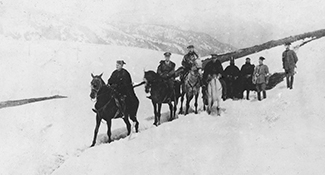
Local and regional governments in both France and Spain have developed educational initiatives about the mountain passes. The French village of Saint-Girons, for example, has a museum called La Maison du Chemin de la Liberté. Historical information is provided about the passeurs, the crossing points, hiding places and what happened to the escapees once they reached Spain.
In Spain, the Diputació de Lleida (the council of deputies), in the Lleida province in Catalonia, has opened five designated routes complete with trail markers. The council also provides tourist information about the hikes and sponsors exhibits such as the one in the village jail in the town of Sort, where many refugees were temporarily incarcerated after being arrested by the Spanish police, known as the Guardia Civil.
“Our project is called Perseguits I Salvats in Catalan, or Persecuted and Saved,” explains Joan Reñe Huguet, president of the Diputació de Lleida. “We are very proud of the role the Catalan people played in helping Jewish refugees and want today’s generation to have the opportunity to walk in their footsteps.”
Spain, of course, was the haven refugees aimed for. Once there, the obstacles were far from over, but on their side were relief groups, the key player being the American Jewish Joint Distribution Committee, also known as the JDC or the Joint, based in Lisbon.
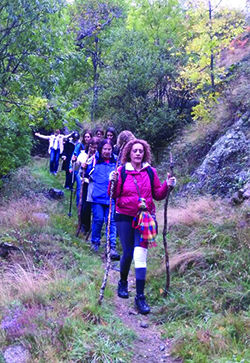 “The JDC created a massive, state-of-the-art, people-moving operation,” explained Linda Levi, the JDC’s assistant executive vice president for global archives. “It required persistence, diplomatic negotiations, time, money and, most of all, creativity to find countries that would accept Jewish refugees and the transportation to get them there.”
“The JDC created a massive, state-of-the-art, people-moving operation,” explained Linda Levi, the JDC’s assistant executive vice president for global archives. “It required persistence, diplomatic negotiations, time, money and, most of all, creativity to find countries that would accept Jewish refugees and the transportation to get them there.”
The JDC’s Barcelona bureau, headed by brothers Samuel and Joel Sequerra, faced intense pressure. Each day, dozens of refugees lined up at its doorstep. Many had been told by their passeurs or by other Jews to “get to the Joint!” To do so, some purposely got themselves arrested by the Guardia Civil, because in prison they hoped to be visited and saved by the JDC. Local citizens were paid by the JDC to notify the Sequerra brothers when Jews were jailed and someone would be sent to free them. From there they would be moved to safe locations.
Jewish men ages 18 to 40 without official papers had a particularly difficult time. If arrested, they were transferred to large detention camps. The most notorious camp was Miranda de Ebro in northern Spain. The JDC, other nongovernmental agencies and international officials worked tirelessly to free Jews from the camps.
“My family was caught at night by the Guardia Civil as we walked toward Barcelona,” Margosis said. “My mother and sister were sent to a women’s jail in the city of Girona, and my brother to a men’s prison, but he was quickly transferred to Miranda. I was the youngest and put in an orphanage.”
A few days later, Margosis was reunited with his mother, Schendel, and sister, Anna, at a JDC-operated residence for women and children in a Catalan village, and they were soon moved to a safe house. Months later, his brother, Willy, was able to join them. Their father, Isaac, a journalist, had fled alone to Portugal in 1940.
Spain was merely a stopover for most refugees. The Manasse brothers lived for a short while in a JDC-run group home for unaccompanied children, which Fred Manasse remembers as being filled with laughter, food and fun. “We finally felt safe,” he said.
The Manasse and Margosis families were sponsored by relatives in the United States and eventually immigrated there. In the States, Michel Margosis enlisted in the Army and fought in the Korean War. He received a master’s degree in chemistry and worked at the United States Atomic Energy Commission and, later, at the United States Food and Drug Administration. Today, he lives in Springfield, Virginia, and volunteers at the United States Holocaust Memorial Museum in Washington.
Fred Manasse, whose parents and sister were killed in Auschwitz, lived with foster families in New York. He earned a Ph.D. in physics, became an electrical engineer and ran a solar energy business. He lives in Waltham, Mass., and is now a full-time artist. He said his prize-winning sculpture, My Diaspora, is about his family losses in the Holocaust. Like Margosis, Manasse lectures on his Holocaust experiences, as does Salter.
Both Salter’s mother, Bronia, and Schendel Margosis had visa issues and made the painful decision to send their children alone to safer shores. In the United States, Salter was brought up by a foster family before being reunited with her family in England in 1947.
Strongly influenced by the Zionist movement, Ruth Usrad immigrated to Palestine. In June 2014, 70 years after she began her escape over the mountains, her son, Hovav, retraced her steps. He went to the Pyrenees with his son, Arad, and niece, Tamar, both in their twenties. “I had a vision ever since I was young to try and follow her escape route,” said Hovav Usrad. “Because we will never know exactly how and where she went, I mapped out a logical route using Google maps.”
Most of the 49-mile trail was in the wilderness, but every 12 miles or so, there were sections that crossed mountain roads. Tamar Usrad hiked with her uncle while his son waited in a car at predetermined meeting points with water, food and a change of clothes.
They began their trek at 2 A.M., Hovav Usrad related, to understand “what it was like to walk into the unknown in the middle of the night.” They took their first steps at the railroad station where Ruth Usrad had first met the man with the black Basque beret, then continued into the backcountry. As they trekked, Usrad left yellow trail markers in case they lost their way. Tamar hiked 31 miles; her uncle finished the last 18 miles on his own. It took him 13 hours to walk the entire route from Quillan to Andorra, the principality where his mother went before entering Spain.
“I practiced for a year,” Usrad explained. “Still, it was not easy. It’s unbelievable what my mother did, nothing short of amazing.”
Ruth Usrad died last October, living long enough to know her son and grandchildren had honored her by following in her footsteps.
Patricia Giniger Snyder is a producer, director and writer at Rembrandt Films in Pound Ridge, N.Y.











 Facebook
Facebook Instagram
Instagram Twitter
Twitter
Jeannette Adler says
Dear Patricia
My book club is reading Kristin Hannah’s book, “The Nightingale.” I just came across your article in the Hadassah magazine, “Over The Pyrenees” and would like to chat with you and perhaps invite you to skype or FaceTime my book club on June 8th.
I look forward to hearing from you!
Sincerely,
Jeannette Adler
P.S. We just finished the book, “The Girl From Foreign” by Sadia Shepard and found the B’nai Israel Jews fascinating!
Patricia Giniger Snyder says
Hi Jeannette. Unfortunately, I just saw this (it is now the 21st of June). I’m so sorry. I hope you had a terrific discussion. Perhaps we can chat as a follow-up. My email is pat@rembrandtfilms.com. Again, I am so sorry to have missed this. Warmest regards.
monique rothscild says
My cousin sent me the article—Over the Pyrenees.
My family crossed the Pyrenees in August 1941 and were able to board a notorious ship, the Navemar, in Seville for the 5-week trip to New York!
Patricia Giniger Snyder says
Dear Monique,
How amazing it is you have written me! I would very much like to talk with you, as I learned about your family’s crossing from a Catalan author who wrote a book about Jews escaping to freedom via the Pyrenees. I am also a documentary filmmaker, working on a project about this. Remarkably, I was trying to figure out how I might contact you! Can we connect through email? Mine is pat@rembrandtfilms.com.
Thank you again for emailing me. I look forward to hearing from you soon! Warmest regards, Pat Snyder
Maria Duarte says
I’m studying the Sequerra brothers, the ones who saved many refugees running from Hitler?
Do you have anything about them? Do you know the film os Nicholas Oulman
Maria Duarte says
I know who took care of the Navemar problem with the refugees, a floating concentration camp…
Joy Danzig says
What a wonderful article! Last spring, while reading “The Nightingale,” I found this article, which so enriche’d my reading of Hannah’s book. Now, I’m preparing to lead a discussion of “The Nightingale” for our Hadassah book group, and I’m going to bring and discuss this article along with the book.
Patricia Snyder says
Thank you so much. Good luck with your bookclub and please let me know how it went!
Jackie says
Hi Patricia,
Do you know if the tour operators still do this trip? I couldn’t figure it out from their website. My father (z”l) lived in the Pyrenees from 1944-45 although he himself did not cross over into Andorra and Spain. I have always been interested to learn more about where he lived and what that time was like. Any ideas?
All the best,
Jackie
Maria Duarte says
I’m studying the Sequerra brothers, the ones who saved many refugees running from Hitler?
Do you have anything about them? Do you know the film os Nicholas Oulman
Claude Benet says
Human remains were found in 2012 near the franco-andorran border where I live. They may belong to a father and a son named Schawb who never made to Andorra. is there any way to trace someone whose relatives died in the Pyrenees?